Walk the floor with Phoenix, step by step
Factory Corner: See How Your Chargers Are Really Made
From production plan to final QA, follow the same route your GaN & wireless chargers take before they carry your brand name.
Factory Corner is built to simulate an on-site factory visit when you can’t be here in person. A short intro video led by Phoenix, followed by photos and process stories, shows how Wecent turns OEM/ODM briefs into finished chargers for phones, laptops and multi-device setups.
1. Intro video: Phoenix leads you through key areas of the factory
2. Photo-led “corners” from line, testing room, aging and packing
3. Step-by-step manufacturing flow from plan to shipment
Wecent Teams
For the people who must trust what they cannot see every day.
You sign off on chargers that your end customers will plug into their phones and laptops thousands of times. Factory Corner is for the teams that need to see the factory reality behind every datasheet.
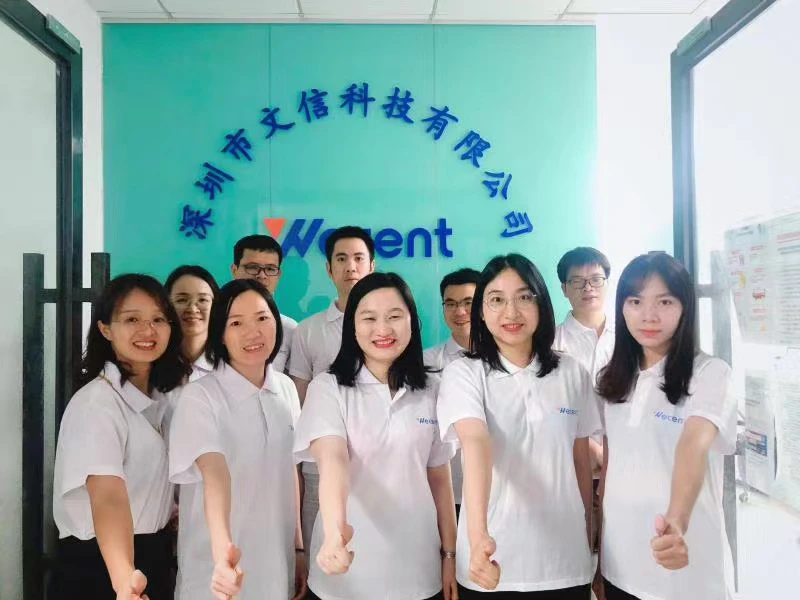
For the sourcing & purchasing lead
From “supplier on paper” to partner you can stand behind.
You compare quotes, lead times and certifications. Here, you also see how production plans, materials and lines are organized to support your schedule and model mix.
- Understand how production planning links to your forecast and orders.
- See that GaN and wireless chargers are built on the same disciplined lines that ship globally.
For the quality & compliance manager
Every test point has a place, not just a checkbox.
From incoming check to aging and QA sampling, we shows where control points sit in the real factory, including ESD discipline, RoHS awareness and shipping inspection reports.
- See how non-conforming materials and units are held for engineering analysis and rework.
- Connect final QA sampling to actual cartons and shipment release decisions.
For the brand & product owner
Where your charging experience quietly takes shape.
You think in terms of unboxing, layout and user scenarios. Factory Corner shows the assembly, finishing and packing corners where your brand elements join our engineering work.
- Follow how enclosure, printing/engraving and accessories come together for each charger.
- Picture your own family of GaN and wireless chargers moving through these same lines.
How a Wecent charger moves through our factory.
This is a simplified version of our internal “Charger Manufacturing Process Flow” – enough to see the discipline without drowning you in engineering symbols.
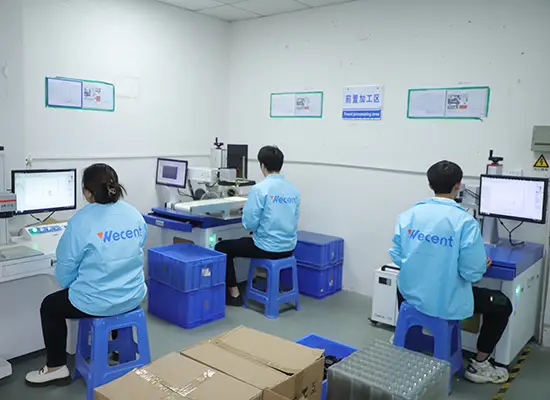
Your forecast becomes a factory route
01. Production plan & material preparation
The cycle starts with a production plan based on your order and forecast. Materials are prepared following the agreed BOM for GaN chargers, phone chargers, wireless chargers and travel chargers, so each model has a clear line loading and batch size.
In parallel, our planning team reviews key chips and long-lead components, reserving them for your projects. By the time operators receive work orders, the right parts are already staged at the right stations, ready for a stable build rhythm.
Only qualified materials enter the line
02. Incoming check & engineering handling
Key parts are checked against specifications. Qualified batches move forward; non-conforming materials are held for engineering analysis and corrective action before any assembly starts or is released to the lines.
When something is not up to standard, engineers issue a clear decision – rework, return or controlled use with your approval. Status labels and storage locations prevent unapproved lots from being mixed into daily production.
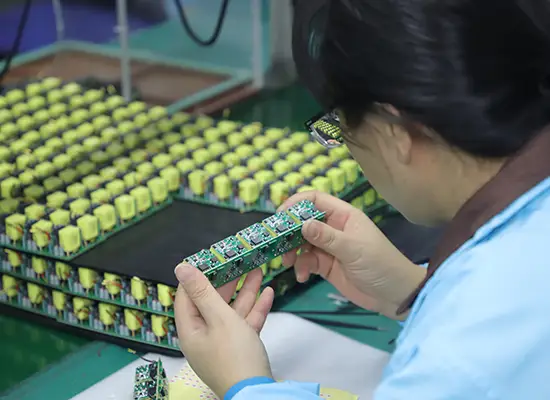

The structure of your charger takes shape
03. Assembly: plug-in, soldering & insulation
Operators carry out plug-in and soldering under work instructions, while insulation sheets and structures keep creepage and clearance distances suitable for compact GaN fast chargers and multi-port phone chargers.
Before running a full batch, a first-piece or trial run is built and checked by line leaders and QC. Once confirmed, it becomes the reference for the order, guiding details like component positioning, wire routing and insulation overlap.
Protecting your user’s devices and your reputation
04. Electrical testing & functional checks
Chargers go through electrical and function tests that verify output, protections and key safety points. Each unit is powered on under controlled conditions so fast-charging performance stays within the window your product team expects.
Failed units are clearly marked, repaired by trained technicians and sent back for full re-test. Test fixtures record results by batch and model, giving you a traceable link between bench data and the products your customers receive.
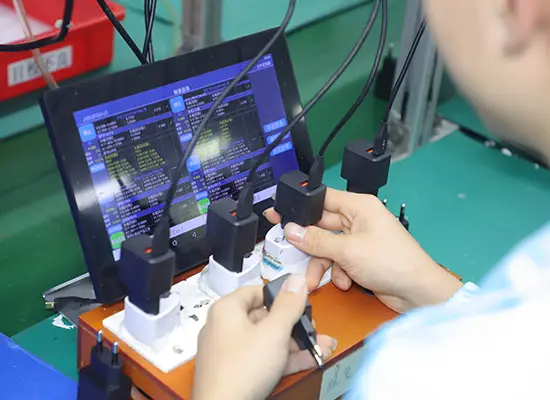
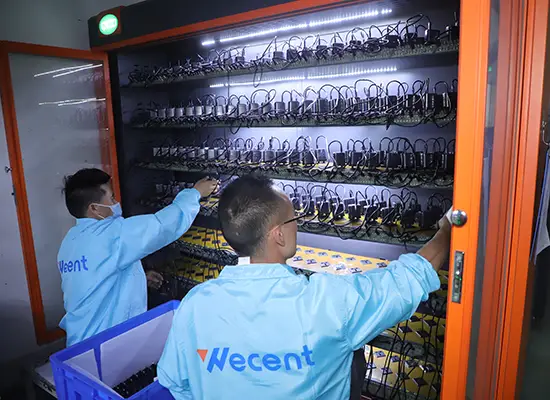
Finding early failures inside the factory
05. Aging & reliability verification
Products are aged under load so abnormal heat, noise or instability can be found inside the factory, not in your customer’s hands. Different power levels and loads are arranged according to model and use scenario.
During aging, operators walk the racks, checking indicators, listening for noise and feeling for unusual temperatures. Suspect units are removed for further analysis, turning this quiet room into an effective filter against early failures.
From “good” to “ready to ship under your brand”
06. Appearance check, QA sampling & shipment
Visual inspection confirms surfaces, marking and ports against approved samples. QA performs batch sampling; only when sampling passes do chargers enter the warehouse and move to the shipping area.
Each shipment is accompanied by a shipping inspection record you can file and refer to. Cartons are labeled with model, quantity and traceable codes, so any future question can be tracked back to this final checkpoint.

What you can’t see in photos, but should know.
- Team members must wear electrostatic bracelets when working with electronic components.
- RoHS and related environmental requirements are considered from material selection to finished goods.
- QA sampling and shipment inspections are recorded, so future batches can be traced when needed.
Walk the corners – almost like being here.
Imagine following Phoenix with a camera: from the gate to the lines, into the testing rooms and aging racks, then out to packing and finished pallets. These are the corners we suggest you show in photos.
Where an RFQ becomes a relationship.
A clean entrance, simple reception and a sample wall that makes it easy to connect model numbers with real GaN and wireless chargers.
Where every charger’s story starts.
Racks of components, labeled and waiting for inspection. This corner tells that material control is not just a line in a quality manual.
The heartbeat of your future SKUs.
Plug-in, soldering, insulation and enclosure assembly happen here on organized lines with clear work instructions at each station.
Where numbers decide who moves on.
Benches with test fixtures verify output, protections and function on every unit before it can enter aging and packing.
The quiet room that filters out the weak.
Racks of chargers run under load. It’s not a glamorous corner, but it’s where many potential field returns are prevented.
Cartons that carry all the work behind them.
Final QA sampling, packing and palletizing. Here, your chargers are weighed, labeled and prepared for the journey to your warehouse.
Want to walk these lines for your next charger project?
Whether you are planning a compact 20W phone charger, a 65W–140W GaN laptop charger, or a wireless charging stand, Factory Corner is just the introduction. Share your requirements and we can arrange a live video tour or on-site visit focused on your models.
